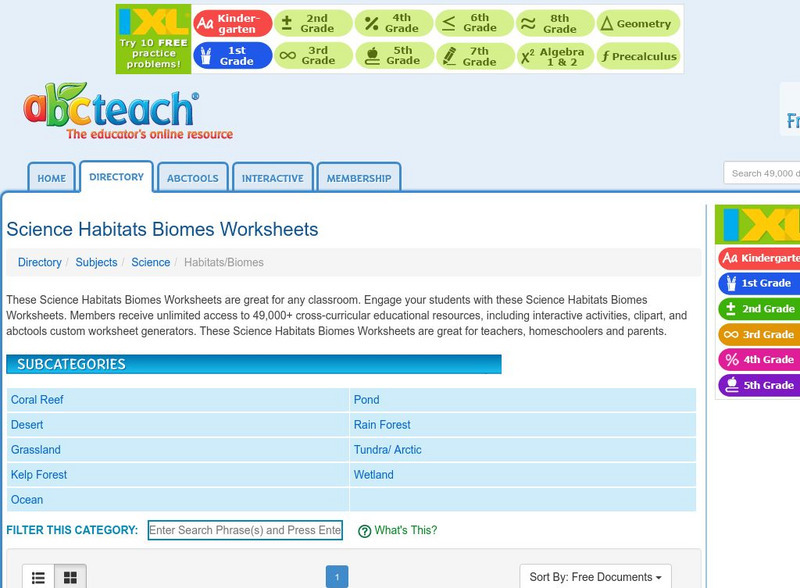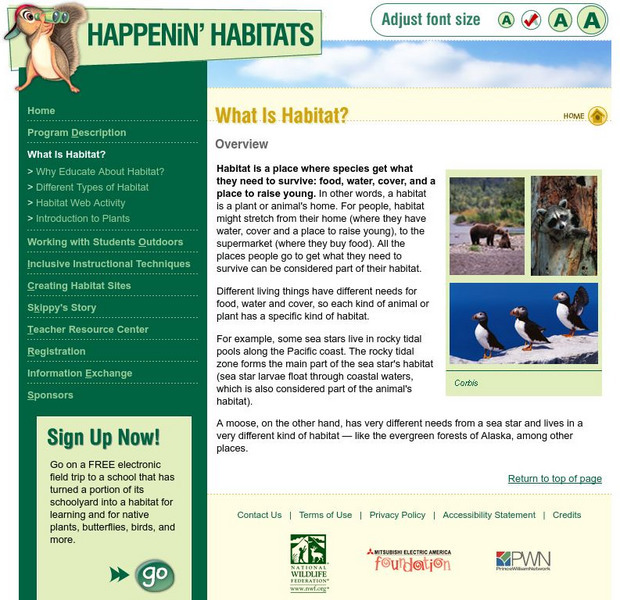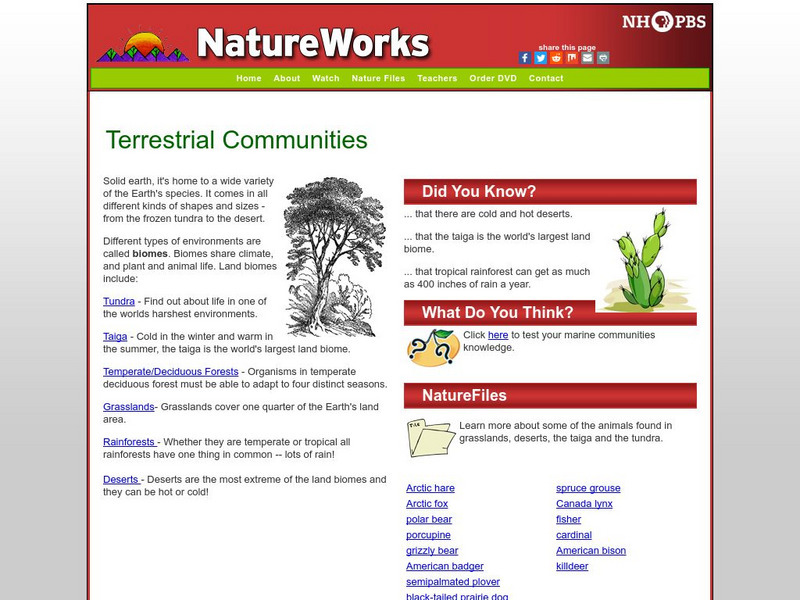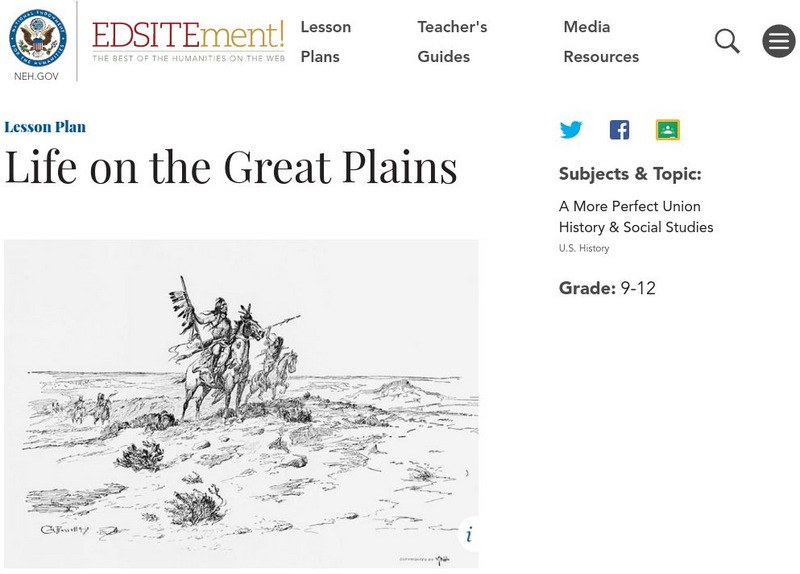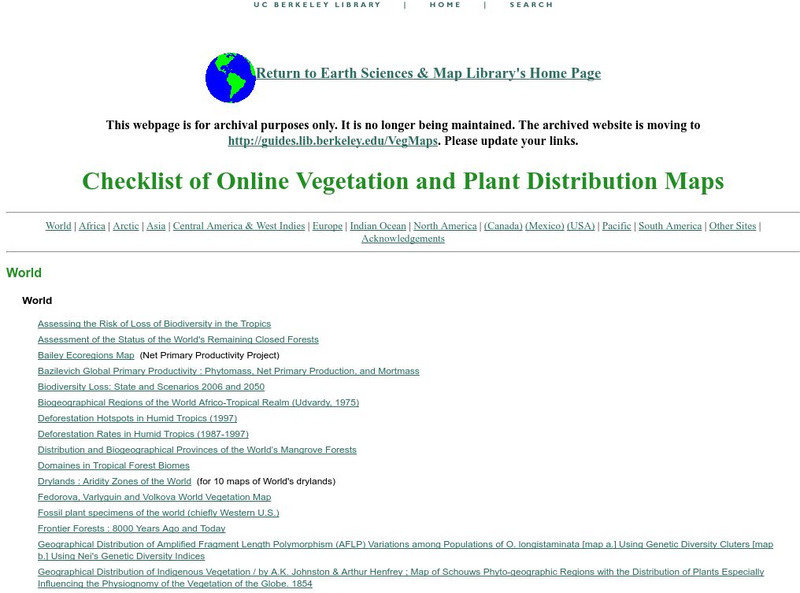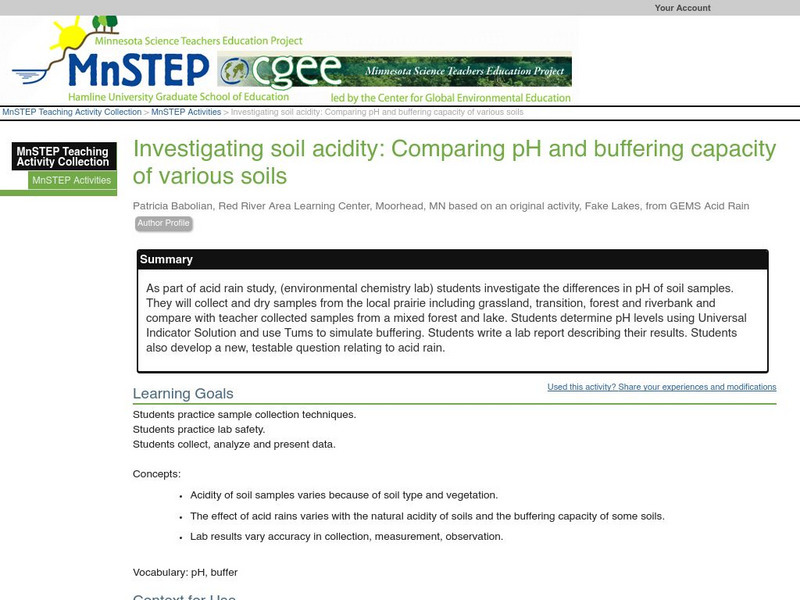Other
Alberta Prairie Conservation Forum
The Alberta Prairie Conservation Forum is a nonprofit organization dedicated to helping to preserve the prairie grasslands. There is a good deal of information here to help one understand the importance of this ecosystem, the threats it...
National Center for Ecological Analysis and Synthesis, University of California Santa Barbara
Kids Do Ecology: Savanna
Learn where savannas are located! Other information at the site from the National Center for Ecological Analysis and Synthesis includes grassland weather, plants, animals, people, and more.
abcteach
Abcteach: Habitats and Biomes
[Free Registration/Login Required] Find a variety of activities for children to do as they learn to identify varying habitats and biomes. Included are links to an even more extensive list of resources under coral reef, desert, grassland,...
National Geographic
National Geographic: Blog: "Fairy Circles" Explained
This article describes how termites create circular patterns of bare soil known as "fairy circles" in the grasslands of southern Africa.
University of Illinois
University of Illinois: Illinois Natural History Survey: The Tallgrass Prairie
This site from the Illinois Natural History Survey provides a large list of grassland plants of the Illinois Tallgrass Prairie - some 851 species. You can find out the common name, scientific name, habitat, flowering period, fruits, and...
Other
National Wildlife Federation: Happenin' Habitats: What Is Habitat?
Find an overview of what a habitat is exactly. Then, for more information, click in the left hand menu for different types of habitat: forests, grasslands, deserts, wetlands, and arctic tundra. Authors also offer advice on creating a...
PBS
Nh Pbs: Nature Works: Terrestrial Communities
Explore land ecosystems around Earth. Learn about forests, tundra, taiga, grasslands, and deserts.
NASA
Climate Kids: 10 Interesting Things About Ecosystems
Discover 10 interesting things about ecosystems, including features of coral reefs, rainforests, deserts, grasslands, freshwater ecosystems, the tundra, the ocean floor, wetlands, boreal forests and big cities.
National Endowment for the Humanities
Neh: Edsit Ement: Life on the Great Plains
A detailed lesson plan that explores "the concept of region and how culture and experience influence the perception of regions." Site provides many excellent websites for students and teachers to explore during their study of the Great...
University of California
U.c. Berkeley Libraries: Plant Distribution Maps
This resource provides a list of online maps of world vegetation such as biomes, forests and plants.
Nature Conservancy
Nature Conservancy: Nash Prairie Preserve
Explore the beauty of America's prairies and examine efforts to preserve this vanishing part of America's landscape.
The History Cat
The History Cat: Geography: People: Argentina's Pampas Cowboys
Describes the geography of the Pampas, or grasslands, of Argentina and the cowboys called Gauchos.
Discovery Education
Discovery Education: Habitats of the World
This site has a lesson plan to use to start a unit on biomes and animal habitats. This plan incorporates grasslands, temperate forests, tropical rainforests, deserts, polar ice regions, and tidepools.
Mocomi & Anibrain Digital Technologies
Mocomi: Major Biomes of the World
Covers the major types of biomes: tropical rain forest, arctic tundra, coniferous forest, deciduous forest, desert, grasslands, and mountains.
Science Education Resource Center at Carleton College
Serc: Investigating Soil Acidity: Comparing P H and Buffering Capacity of Soils
As part of acid rain study, (environmental chemistry lab) middle schoolers investigate the differences in pH of soil samples. They will collect and dry samples from the local prairie including grassland, transition, forest and riverbank...
University of Nebraska
University of Nebraska: Racer
The University of Nebraska presents information on the Racer. A nonpoisonous snake found in the prairies and grasslands of Nebraska. A color photo and description are included.
Encyclopedia of Earth
Encyclopedia of Earth: Ocean Oil: Coastal Ecosystems
A collection of articles, video, and some teaching guides on issues related to coastal ecosystems. Includes environmental issues, e.g., oil spills, and different types of ecosystems, e.g., mangroves and coastal grasslands.
Encyclopedia of Earth
Encyclopedia of Earth: Biodiversity
A large collection of articles, news items, photos, slideshows, animations, and scientific reports, all related to biodiversity. Many articles on different ecosystems, e.g., deserts, grasslands, forests, etc. An excellent resource for...
US Forest Service
U.s. Forest Service: Celebrating Wildflowers: Wildflower Viewing Areas
This wildflower map links to hundreds of national forest and grasslands sites in the U.S. where the enthusiast can enjoy views of wildflowers in their natural settings. Each site has detailed information about the location, what you will...
University of Nebraska
University of Nebraska: Bull Snake
The University of Nebraska presents information on the Bull Snake, a nonpoisonous snake found in grasslands, woodlands, and farmlands. Map of Nebraska and similar species links included.
The Association of the British Pharmaceutical Industry
Abpi: Human and Animal Habitats
An interactive learning game where students answer whether or not certain environments would be suitable for different animals. Printable worksheets are available for review at the end of the activity.
Other
Eco Library: Panoramas
Features amazing 360 degrees interactive panoramas for students to help them better understand ecological variation on our planet. Searchable by biome/ecosystem type, location, or ecological phenomena they depict.
The Wild Classroom
The Wild Classroom: Biomes
This excellent resource explores all of the biomes found on planet Earth! A side menu indicates the world's biomes and provides details on each. Colorful interactive maps, video clips, lesson plans, species profiles, and so much more...
Smithsonian Institution
National Museum of Natural History: Paleobiology: Geologic Time: The Oligocene
Travel through Earth's history to learn about the Oligocene time period, which is characterized by the appearance of most of the living families of mammals.
Other popular searches
- African Grasslands
- Grassland Biome
- Grasslands Biome
- Grasslands Animal Homes
- Grassland Animals
- The Grasslands
- Grasslands Plants
- Temperate Grasslands
- Grasslands Project
- Grasslands Ecosystems
- Grasslands of Africa
- Grasslands Lesson Plans


